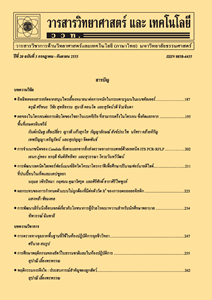ผลของการใช้วัสดุเพาะและวัสดุอาหารเสริมชนิดต่าง ๆ ร่วมกับกลุ่มจุลินทรีย์และน้ำหมักชีวภาพต่อผลผลิตเห็ดฟางที่เพาะในตะกร้าพลาสติก
Main Article Content
Abstract
บทคัดย่อ
การพัฒนาเทคโนโลยีการเพาะเห็ดในตะกร้าได้ดำเนินการในโรงเรือนทดลอง ภาควิชาเทคโนโลยีการเกษตร มหาวิทยาลัยธรรมศาสตร์ (ศูนย์รังสิต) ปทุมธานี ตั้งแต่เดือน เมษายน 2551 – เมษายน 2552 ประกอบด้วย 3 การทดลอง ดังนี้ 1) เปรียบเทียบผลผลิตเห็ดฟางในการเพาะด้วยการใช้ฟางข้าว, ขี้เลื่อยผ่านการเพาะเห็ดมาแล้วและขี้เลื่อยไม้ยางพารา โดยการแช่ฟางข้าวเป็นเวลา 12 ชั่วโมง ในน้ำหมักจุลินทรีย์อีเอ็ม (EM) ในน้ำหมักจากสูตร สถาบันวิทยาศาสตร์และเทคโนโลยีแห่งประเทศไทย, ในน้ำที่ผสมกับเชื้อจุลินทรีย์ พด 1,2 และ 3 (กรมพัฒนาที่ดิน) เชื้อ Bacillus subtilis (Bs) จากมหาวิทยาลัยเกษตรศาสตร์ และแช่น้ำเปล่า ส่วนขี้เลื่อยที่ใช้แล้วและขี้เลื่อยใหม่หมักเป็นเวลา 9 วัน กับน้ำหมักจุลินทรีย์และน้ำผสมจุลินทรีย์ต่าง ๆ เช่นเดียวกันกับการทดลองฟางข้าว มีการวางแผนแบบ Factorial (3x5) in RCBD มี 5 ซ้ำ ๆ ละ 1 ตะกร้า ผลการทดลอง พบว่า การเพาะด้วยฟางข้าวแช่น้ำ 12 ชั่วโมง ให้ผลผลิตสูงสุด 529.40 กรัม/ตะกร้า แตกต่างอย่างมีนัยสำคัญทางสถิติกับสิ่งทดลองอื่น ๆ ส่วนขนาดของดอกไม่แตกต่างกัน 2) เปรียบเทียบผลผลิตการเพาะเห็ดฟางในตะกร้าโดยใช้ฟางข้าวแช่น้ำ 12 ชั่วโมง เป็นวัสดุเพาะ (คัดเลือกจากการทดลองที่ 1) แต่ใช้วัสดุที่เป็นอาหารเสริมแตกต่างกัน ดังนี้ ใช้ภูไมค์ ขี้ฝ้าย ผักตบชวา รำละเอียด และเปรียบเทียบกับการใช้ผักตบชวาเพาะร่วมกับขี้เลื่อยที่ผ่านการเพาะมาแล้ววางแผนแบบ RCB มี 5 ซ้ำ ๆ ละ 3 ตะกร้า โดยใช้อาหารเสริมในอัตรา 6% ของ นน.แห้งวัสดุเพาะ ผลการทดลอง การใช้ขี้ฝ้ายเป็นอาหารเสริมนั้นให้ผลผลิตสูงสุด คือ 572.52 กรัม/ตะกร้า ส่วนขนาดของดอกไม่แตกต่างกัน 3) ทดลองหาปริมาณที่เหมาะสมของการใช้ขี้ฝ้ายเป็นอาหารเสริมโดยทดลองในอัตรา 2, 4, 6, 8 และ 10% วางแผนการทดลองแบ RCBD มี 5 ซ้ำ ๆ ละ 3 ตะกร้า ผลการทดลองพบว่าการใช้ขี้ฝ้าย 8% ของวัสดุเพาะหรือประมาณ 200 กรัม/ตะกร้า มีแนวโน้มให้ผลผลิตสูงสุด 562.10 กรัม/ตะกร้า
คำสำคัญ : วัสดุเพาะ; วัสดุอาหารเสริม; กลุ่มจุลินทรีย์; น้ำหมักชีวภาพ; เห็ดฟาง
Abstract
Technology development of straw mushroom cultivation in plastic basket was conducted at the Department of Agricultural Technology, Thammasat University, Pathumthani during April 2008 - April 2009 comprising 3 experiments as follows 1 ) Comparison of production yield of straw mushroom cultivated by using rice straw, Oyster mushroom substrate residues and pararubber sawdust as substrates. Rice straw was treated by soaking for 12 hours in water, effective microorganism bioextract (EM), bioextract prepared according to the formula of Thailand Institute of Scientific and Technological Research (TISTR), in dilution of Bacillus subtilis from Kasetsart University and in dilution of mixture of bioactive powder formulation No. 1, 2 and 3 of Land Development Department (LDD). Mushroom substrate residues and sawdust were treated for 9 days by fermenting with water, bioextract and bioactive microorganism as mentioned above. The experiment was designed in Facterial (3x5) in RCBD with 5 replications. The result revealed that straw mushroom growing on rice straw soaked in water for 12 hours gave the significantly highest production yield in terms of fresh weight 529.40 gm/basket 2 ) Comparision of production yield of straw mushroom grown on rice straw substrate selected from the trial 1 with different supplements (6% of dry weight of substrate) : waste cotton, pumice, rice bran, fresh water hyacinths were compared to the treatment of using Oyster mushroom substrate residues as substrate supplemented with fresh water hyacinth. The experiment designed in RCBD with 5 replications, showed that the substrate supplemented with waste cotton gave the significantly highest yield (572.52 gm/basket) 3 ) Straw mushroom cultivated on rice straw substrate supplemented with different rates of waste cottons, 2, 4, 6, 8, 10 percents of dry weight of substrate showed no significance in producing yield between 485.20 – 562.10 gm/basket; while the 8% supplement tended to give the highest yield.
Keywords: cultivation substrate; supplemented materials treated; effective microorganism; bioextracts; straw mushroom


